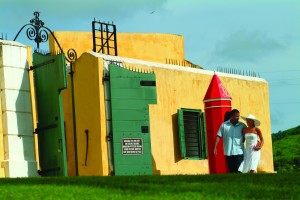
It wasn’t that long ago in human history when many of the islands of the Caribbean had to be well fortified due to the wider conflicts between the kingdoms and empires of Europe and even closer within the blossoming Americas. The surviving legacy of these earlier eras often includes some fascinating forts across the region which reflect those defensive needs. Impressive architectural exterior detail, often along with well-preserved interiors, all provide insight into daily life and customs of those more turbulent times.
Getting there? The following forts are easy enough to access, located either in or near the capital, even sometimes within walking distance from urban centers. You can also find them within reach through guided tours. Once there, observe not only the architectural grandeur but also the often exhilarating vistas of town, shoreline and even island interior. Along the way, you may find your own historic fort encounter to be both a step back in time and even a welcome interlude from the bustle of the resort world.
Bahamas – Fort Fincastle, New Providence
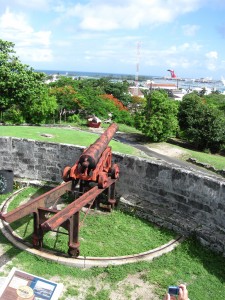
For a small island with a dimension of just seven by twenty-one miles, New Providence was remarkably well-fortified during its long colonial period. Then again, the Bahamas were a longtime important port of call for maritime traffic into the Caribbean and a strategic point on the map in guarding British colonial and naval presence. Named for the then-governor of the island (Lord Dunmore, Viscount Fincastle), Fort Fincastle was completed in 1793 and remains the most central of this island’s three historic fortifications, but is also interesting for some aspects that are all its own.
What’s special here – and what to do while visiting: “Massive” is usually a standard word in describing forts, but Fort Fincastle is quite small and compact. It also stands at the highest point on New Providence, being some 200 feet above sea level, providing incredible views of the capital of Nassau and its harbor from its 126-foot tall water tower. With its maximum elevation, it also went on to serve as a lighthouse into the early nineteenth century. Also a short walk from the Fort is the imposing Queen’s Staircase, a slave-built stone stairway stretching down hundreds of stone-etched steps. Along the road leading up to Fincastle is a collection of vendors selling island straw crafts. The fort is ideal for a visit if you’re exploring the central Nassau area. Fort Fincastle is open daily from 8 am to 4pm.
Jamaica – Fort Charles, Kingston
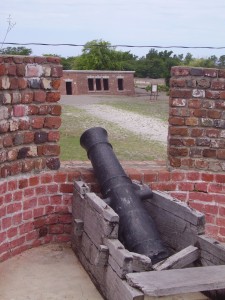
While many travelers to Jamaica flock to the coastal attractions located close to the all-inclusive mega-resorts on the north coast, those who appreciate the historical high points and surviving colonial era legacy of this island should make time for Fort Charles, located in the Port Royal area on the Palisadoes. The location is rich in lore derived from the long-ago presence of both stellar naval heroes and legendary pirates, each leaving their own historic footprint in the accounts of the fort’s legacy.
What’s special here – and what to do while visiting: Fort Charles is the earliest historic structure present within Port Royal, its foundations laid by the British following their capture of the island from the Spanish in 1655. Today, British cannons still stand guard along sections of its upper perimeter, and visitors can also explore some of the interior areas below including the dungeons that held notorious pirates. Fort Charles also withstood natural disasters in the form of major earthquakes – one of which in 1692 sank much of Port Royal itself. Also worth a visit is the adjacent small National Museum of Historical Archaeology (Tel: 922-1287), located in the former naval hospital. It houses an intriguing variety of items retrieved from the submerged port area destroyed in the great earthquake. Fort Charles is open daily from 9 am to 4:45 pm.
St. Croix, USVI – Fort Christianvaern, Christiansted
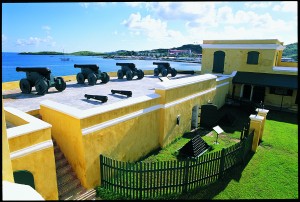
Dating back to 1749, this imposing structure is also the island’s most visible example of Danish military architecture. Fort Christianvaern was also the first public building the Danes began work on after acquiring St. Croix from the French in 1733. Visitors will enjoy the ocean-facing views from its upper outdoors where cannons still point outward against naval threats, though the cannon here never had to be used in any actual conflict. The fort was maintained as both a functioning prison and a courthouse after 1878.
What’s special here – and what to do while visiting: This Danish-constructed edifice was built from yellow Danish brick, making it very distinct outwardly from the usual grey or colorless stone you observe in forts elsewhere. The present restoration reflects the 1830s, with furnishings from that period on display in the décor of the soldier barracks as well as an exhibit on local military history. Take time to stop by the neighboring Old Customs House which has a wonderful grand staircase and is home to National Park Service offices. Fort Christianvaern is open from 8 am to 5 pm during the week and 9 am to 5 pm on weekends.
Puerto Rico – Castillo de San Felipe del Morro, Old San Juan
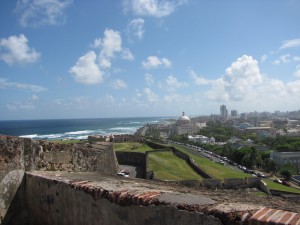
Guarding the maritime entrance to the old and modern city of San Juan, another of Old San Juan’s major historic landmarks is the Castillo de San Felipe del Morro, or the “El Morro” Fortress. From its dominant position guarding the San Juan Bay, soldiers fought off attacks by both the English and the Dutch. Nowadays, the fort’s six-level structure and extensive surrounding park landscape along its approach make it a popular daytime destination for all kinds of local and visiting audiences – couples walking kids, kite-flying enthusiasts taking advantage of the headwinds, and people enjoying the exercise of walking or running amidst a spectacular setting.
What’s special here – and what to do while visiting: Scale, size, detail, preservation – all of these are abundantly present at El Morro. For some visitors, the memories they take away may be of the smaller outward fixtures such as the guard turrets that jut outward towards the Caribbean, or of the gray castellated lighthouse, or the bilingual displays and videos that describe the construction over 200 years (original fortification dating back to the fifteenth century). While many forts do have magnificent panoramas from their uppermost levels, the views towards the Caribbean and both modern and past San Juan are a visual tapestry from a perfect elevation. “El Morro”, the Castillo de San Felipe del Morro, is open daily from 9 am to 4 pm.
St. Vincent – Fort Charlotte, Kingstown
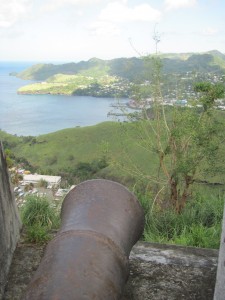
Situated some 660 feet above the capital of Kingstown and providing fine views of the coast, the Grenadines, and the city below, Fort Charlotte distinguishes itself from most other Caribbean fortifications because its cannons pointed inland to protect against attacks by the French and the Carib Indians. Completed in 1806 and named after the consort of King George III, Fort Charlotte in its day was equipped with some 34 pieces of artillery and had barracks for 600 men.
What’s special here – and what to do while visiting: With a site chosen to protect as much from interior intrusion as attacks mounted from offshore, Fort Charlotte nowadays allows the visitor to survey it all from its battlements. Beyond all that, there is also much to view onsite since the fort once consisted of more than just the main ramparts and barracks at the crown of the hill. Some rooms of the fort are now used for interpretation of history and culture of the country, and in the former officers’ quarters you can view vivid paintings on the walls of the island Caribs’ history by artist Lindsay Prescott. While in the area, travelers may also want to stop off at the nearby Botanical Gardens, dense with rare exotic flowers, plants, teak, mahogany, and cannonball trees. Pause on your way out for a short visit with the large and brilliantly colored St. Vincent parrots. Fort Charlotte is open from 8 am to 3 pm, Monday through Friday.

